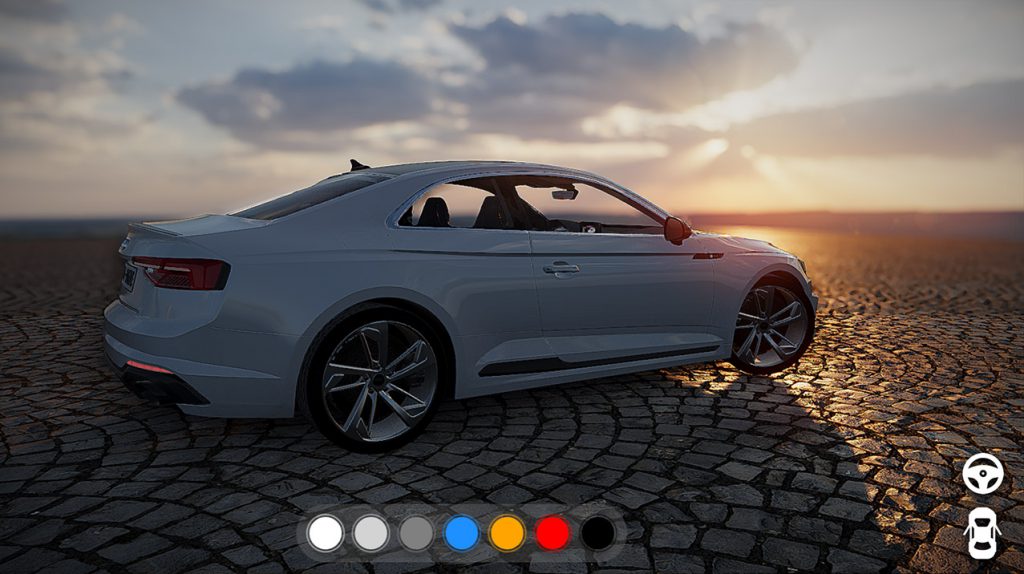
WaveEngine 3.2 Preview


We are glad to announce that, aligned with Microsoft, we have just released WaveEngine 3.1 with official support for .NET 5 and C# 9. So if you are using C# and .NET 5, you can start creating 3D apps based on .NET 5 today. Download it from the WaveEngine download page right now and start creating 3D apps based on .NET 5 today. We would like to share with you our journey migrating from .NET Core 3.1 to .NET 5, as well as some of the new features made possible with .NET 5.
To make this possible we started working on this one year ago, when we decide to rewrite our low-level graphics abstraction API to support the new Vulkan, DirectX12 and Metal graphics APIs. At that time, it was a project based on .NET Framework with an editor based on GTK# which had problems to support new resolutions, multiscreen or the new DPI standards. At that time, we were following all the great advances in performance that Microsoft was doing in .NET Core and the future framework called .NET 5 and we decided that we had to align our engine with this to take advantage of all the new performance features, so we started writing a new editor based on WPF and .NET Core and changed all our extensions and libraries to .NET Core. This took us one year of hard work but the results comparing our old version 2.5 and the new one 3.1 in terms of performance and memory usage are awesome, around 4-5x faster.
Now we have official support for .NET 5 and this technology is ready for .NET 6 so we are glad to become one of the first engines to support it. This is an overview of what we are building with WaveEngine 3.1 and .NET 5:
We are using the .NET 5 stack on all platforms where it is possible, Windows, Linux, MacOS and Web and we use the Mono stack where it is not possible, but we are ready for .NET 6 so that we can finally unify this to use single .NET stack for all our supported platforms. One of the most interesting features that you can see in this diagram is that WaveEngine is easy to integrate with several user interface technologies like WPF, Windows Forms or SDL. If you need to integrate a 3D graphics viewer for data visualization inside new projects with .NET 5 this is a great technology to use.
Another interesting technology in .NET 5 is a new compiler called “dotnet-wasm” with the ability to compile C# code directly to WASM to run in web browsers. Microsoft is pushing this technology as the heart of Blazor and we are able to take advantage of this to run WaveEngine on the web platform using dotnet-wasm, emscripten and WebGL/WebGPU. It is something that we have been dreaming of for years and now it is possible, here you can see it in action with project Paidia:
(The Project Paidia demo is a simple game with a new artificial intelligent model running using ONNX.js and WaveEngine on the browser)
With the new .NET 5 release we will also publish a new tool inside our standalone editor to edit the postprocessing pipeline with a graph editor. We believe this is something new in this area which will allow users to design professional postprocessing pipelines in theirs apps. It looks like this:
The new postprocessing pipeline is completely based on Compute Shader where it is possible to apply new techniques such as LDS (Local Data Share) to improve the standard performance based on Pixel shader. Every box in the editor graph is a compute shader with inputs and outputs, the user can write their compute shader in our effects editor or use some of the built-in ones included in the new version.
For our Standard Material the new version comes with a Standard Post-Processing graph that users can edit to adapt to their needs. The standard graph comes with all these techniques: TAA (temporal antialiasing), Bokeh DoF (Depth of Field), SSAO (Screen Space Ambient Occlusion), SSR (Screen Space Reflections), Camera Motion Blur, Bloom, Grain, Vignette, Color Gradient and FXAA.
In this video you can see all these techniques applied at the same time in a demo project:
Start developing 3D apps with .NET 5 and C# 9 right now following these next steps:
We are thrilled to bring you a new preview of Wave Egine.
The fourth preview comes with a lot of changes in the WebGL implementation. We have focused on improving the performance of this platform and adding experimental support for WebGL 1.0.
The main change is the use of Emscripten for calling EGL directly from C# and allowing the use of AOT when the project is built. This means a performance boost of up to 10 times.
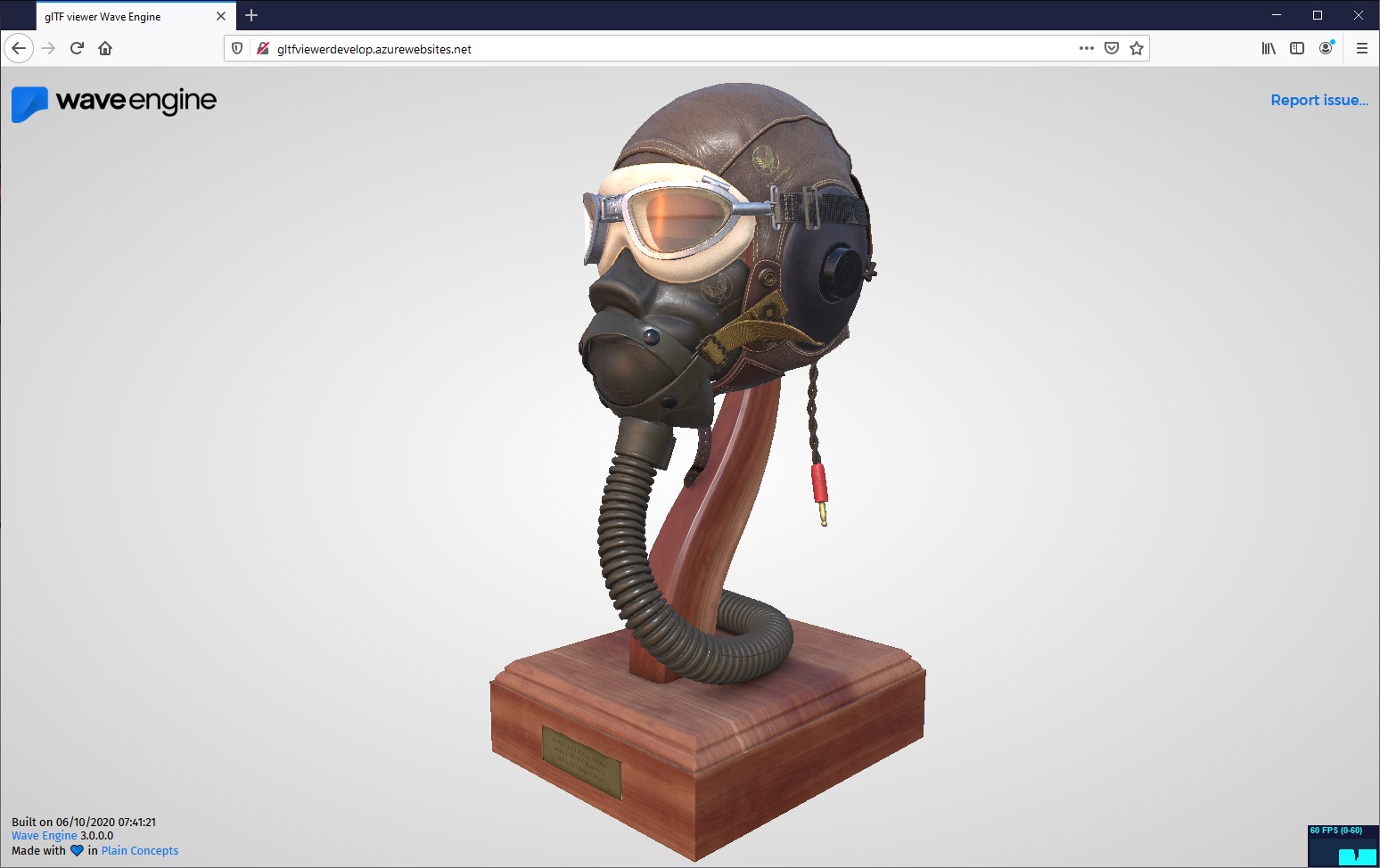
We’ve worked hard to port the Visual Editor to NetCore 3.1, which will allow us to move to Net 5 when the stable release is launched.
Also, now the Visual Editor allows you to write Compute shaders and preview its changes on output textures, and also we’ve integrated RenderDoc for capturing frames and analyzing them.
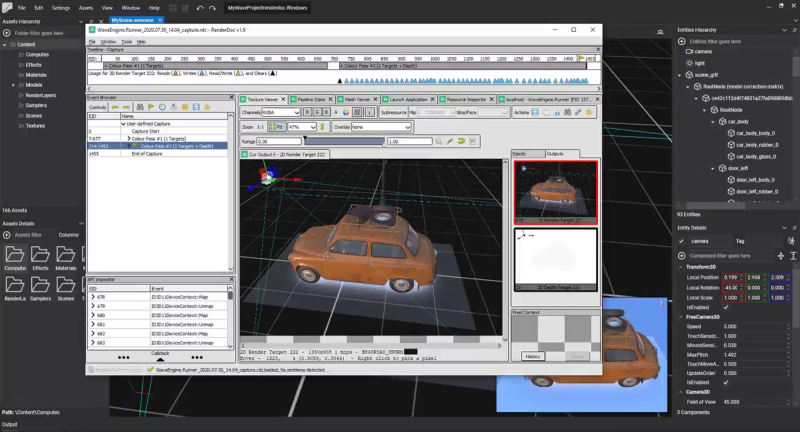
This version made possible to add Skinning in models using Compute Shaders in the supported platforms. This proved to be 4 times faster than our previous system, due to the amazing parallel performance.

Finally, we have created a new integration for Azure Remote Rendering, that is available in GitHub.
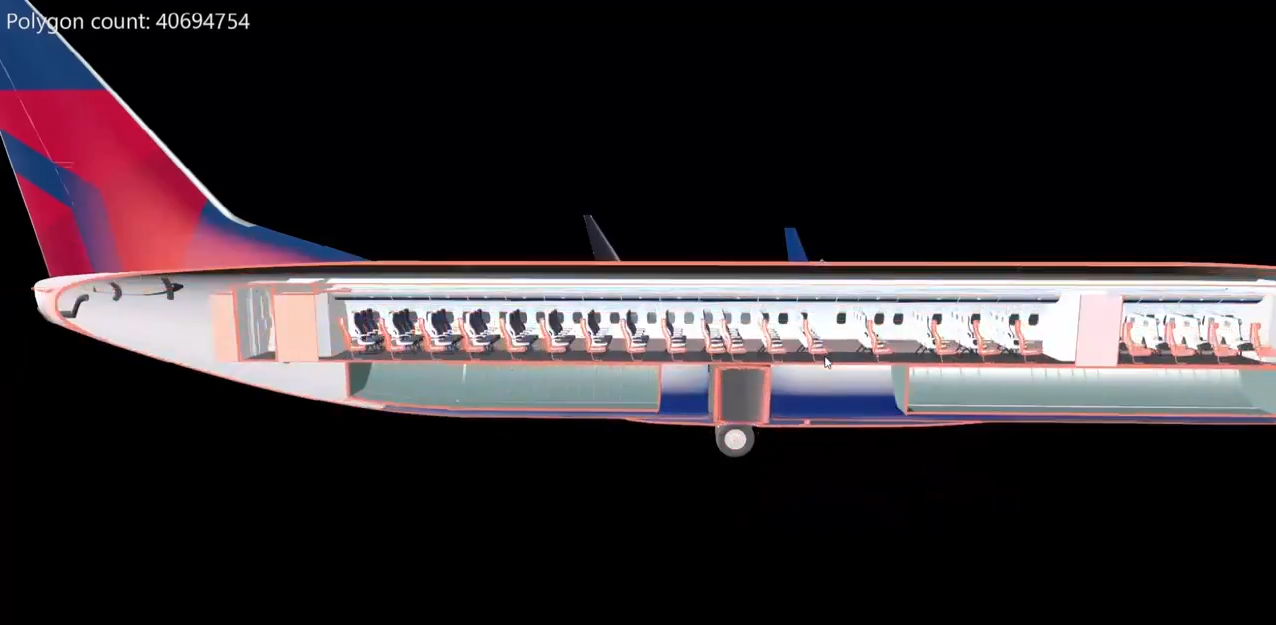
WebAssembly (Wasm) is the not-so new standard to run high performance code in the browser, in the client side. You can think of it as an optimized Virtual Machine (VM), which translates intermediate code, bytecode, into the target machine architecture, all of it within a secured sandbox. It is not a replacement for JavaScript, it is not the silver bullet, but has allowed us to think of the Web as another desktop target for .NET, in the same way Windows, macOS, Android or iOS, among other ones, already are.
You can right now run your .NET Core Console app embedded in a HTML file, make web requests, access the File System (FS), draw stuff with WebGL (the Web branch for OpenGL), and a lot of more things, just because it is the .NET runtime being executed in Wasm. There are still steps to be taken in order to make things smoother for us the Developers but, at the same time, begins to be mature enough for using along projects.
Continue reading Wave Engine runs on the Web thanks to Mono Wasm
We are excited to announce the release of Wave Engine 3.0 third preview!
In this one we have worked hard to include a new template for Web applications. The launch of Mono Wasm has allowed us to deploy your Wave Engine apps to the browser, although there are some limits at the moment (such like native libraries: Bullet Physics, Noesis GUI, etc.) You can read our post about the glTF viewer we have launched to find some details about the implementation.
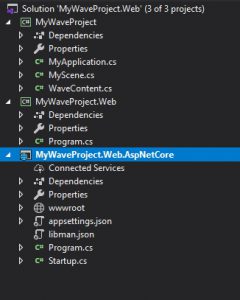
Also, the engine has been updated to support HoloLens 2, integrating the new APIs and updating the Mixed Reality template.
Furthermore, we have integrated Physically Based Rendering (PBR), enabled by default in the Standard Material, and new photometric lights and cameras that will improve the render quality.
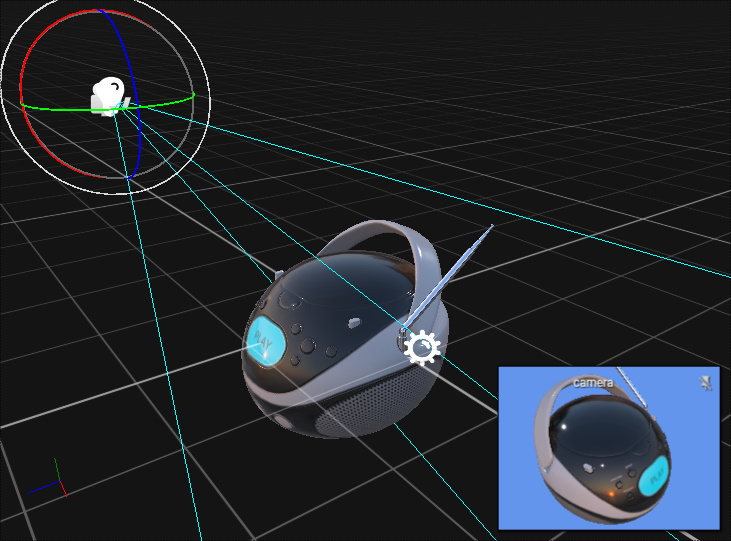
TL;DR: We are announcing our experimental glTF on-line viewer made with Wave Engine 3.0, powered by WebAssembly. Try the demo! http://gltf.waveengine.net
During dotNet 2019, on past june, we presented our initial support for WebAssembly (Wasm), showcasing our WebGL.NET library which serves us to draw at a low-level layer. On the following months we worked on refactoring the OpenGL piece into a platform-agnostic WaveEngine.OpenGL.Common one, from where WaveEngine.WebGL was born. By the end of the year our visual tests started to pass, and we were ready for testing such in a more real scenario.
Our current WebGL backend relies on its 2.0 version, which is supported by most of the browsers: the new Edge (based in Chromium), Firefox and Chrome. Although Safari allows to enable WebGL 2.0 through its Experimental Features menu, it is not 100% completed and breaks when running our app. If you are on macOS, please try Chrome or Firefox; on iOS, it is currently not possible because every browser relies on WebKit, Safari’s foundation.
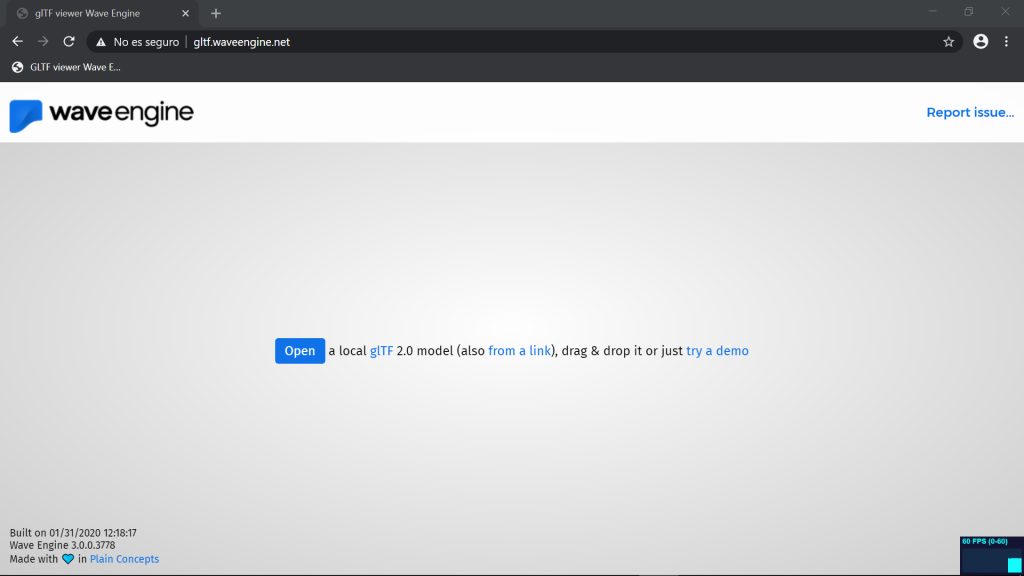
glTF viewer is a SPA (Single Page Application, a website run on a single page) which works entirely in client side, powered by Mono’s support for Wasm, which will be included in .NET 5. glTF is the nowadays standard for 3D models, and can be viewed on-line by simply drag & dropping such inside —we’ve included a demo-mode for those without a handy file close. Its main features pack:
This article will visit a few caveats we found during the development, and how we surpassed them finally. We hope you enjoy reading such and, hopefully, will learn something new in between.
That is not actually true. However, that is the point where we found our-selves when began to work on this project: Wave Engine relies on the concept of content, a path in the FS where the assets are placed. Such assets are, in most of the cases, preprocessed in compile-time. When an app starts the assets are ready to be consumed by the engine.
Thinking on dropping a set of glTF files within a web page, we needed to drive through the content pipeline in order to process the model through our glTF importer. Along with Kenneth Pouncey (thank you!), from Mono, we had already rewrote in C# the Emscripten’s tool to build a Virtual FS (VFS), Mono.WebAssembly.FilePackager, by specifying a local path; however, how do we write there files coming from the outside? Emscripten has solved this already, by offering a FS API in JavaScript, in a flavour similar to common I/O operations:
function writeToFS(filename, typedArray) {
// TODO would there be any other way without handling exceptions?
try {
FS.stat(DropAbsoluteDirectory);
} catch (exception) {
FS.mkdir(DropAbsoluteDirectory);
}
let destinationFullPath = DropAbsoluteDirectory + '/' + filename;
let stream = FS.open(destinationFullPath, 'w+');
FS.write(stream, typedArray, 0, typedArray.byteLength, 0);
FS.close(stream);
}
This functions writes the bytes at typedArray into Emscripten’s VFS
Solved this, the next issue we found was how to overcome the glTF files dropped were not processed in any way, and Wave Engine “does not support” reading such on the fly. The quotes are intended, as we do support such: dropping such in the Editor renders the model immediately, but there is some magic underneath.
We started exploring to consume WaveEngine.Assets namespace inside and app, instead of just from the Editor, which was its natural environment. And voilá, it worked! When a .glb file (the single binary format for glTF) is dropped:
One of those files is the actual model, which later is used to instantiate the entire entity hierarchy added to the scene. It is not a heavy process when run on the desktop but, when used from Wasm, it takes some precious seconds. Mono has recently added support for multi-threading but, until such will not be broadly adopted by most common browsers, we still cannot rely on it, although will definitely help us reduce such time, as we currently process items one by one.
One of the most time and memory consuming tasks above process takes is texture importing, which will cover next.
Of the large bunch of models we have tested those days, the most common textures are made of 2048 x 2048 pixels. When we read such the pixel format is expressed as RGBA, which means 4 bytes per pixel. Thus, if we want to allocate space to read the image in memory we need arrays of 2048 * 2048 * 4 bytes, which is a lot. We have found in some minor cases 8K textures, which make such even worse.
Allocating memory it-self is not a problem, Wave internally depends on ArrayPool for importing textures, which at least makes that smoother. Textures are handled by our ImageSharpImporter, SixLabors’ ImageSharp, which we chose mainly because of its cross-platform feature but, under Wasm, there is a large room open for improvement. With big numbers, decoding a 2048 pixels side image can take more than 10 s, which breaks the experience with no doubt. (We have found also blockers with AOT, but eventually workarounded such by disabling the stripper on their assemblies.)
How, then, can we read images faster? For our WebGL.NET samples gallery, our friend Juan Antonio Cano consumed Skia through some initial .NET bindings, and already solved such by taking some hundred ms. However, the current state of such bindings, made by Uno team, were not compatible with vanilla Mono Wasm, thus we looked for an alternative thinking on maintenance in a future. Also important, we only needed the small piece to decode an image, and nothing else.
It turns out CanvasKit (“Skia in Wasm”, quickly), exposed such piece, and has a JavaScript interface. We made some tests in the CanvasKit playground and looked promising. Then, our CanvasKitImporter was born —replacing ImageSharp one.
private JSObject DecodeImage(Stream stream)
{
if (!stream.CanSeek)
{
throw new ArgumentException("The stream cannot be seeked", nameof(stream));
}
stream.Seek(0, SeekOrigin.Begin);
JSObject image;
using (var memoryStream = new MemoryStream())
{
stream.CopyTo(memoryStream);
using (var array = Uint8Array.From(memoryStream.GetBuffer()))
{
image = (JSObject)canvasKit.Invoke("MakeImageFromEncoded", array);
}
}
return image;
}
CanvasKitImporter.DecodeImage() passes the underlying byte array to CanvasKit, which decodes the image
Loading models like FlightHelmet took from minutes (15-30) with the tab frozen to less than 20 s. And it still takes too much for us, but we must recall the asset export & import process is untouched from the desktop code. We initially though the ArrayPool.Rent(length) call was forcing Garbage Collector (GC) to pass and incurring in some seconds but, after isolating such calls, it is not the culprit at all. We still need to investigate here more in depth.
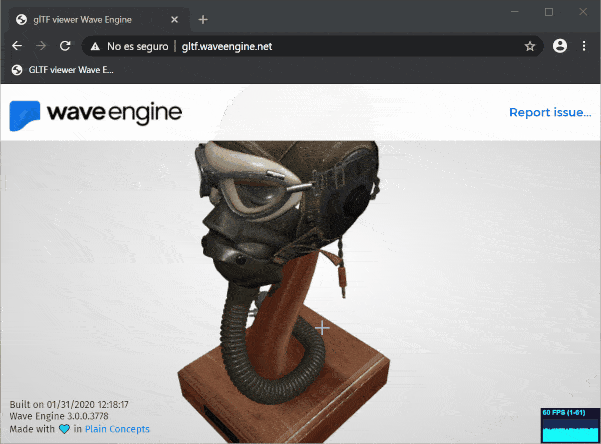
Not everything is solved: loading time for very big models must be reduced, memory allocation must be decreased too, our WebGL abstraction can be faster as well. Nonetheless, this glTF viewer is our first public project made with Wave Engine 3.0 for the Web.
We have pursued such during some time but the scenario was still not ready for the jump. Nowadays, we see a bunch of possibilities for helping our customers to take visual experiences into the browser, adding Web to the list of officially supported platforms.
If you think we can help you reach the Web too, we are here to listen. Oh, and if you found any issue, please report it. Thank you for reading.
We’re excited to announce the release of WaveEngine second preview. In this new preview, the whole engine uses .NET Core 3.0, so all WaveEngine libraries are .Net Standard 2.0 and new project templates are .NET Core 3.0. You can just get .NET Core by simply upgrading to Visual Studio 2019 16.3.
Furthermore, you can now run your WaveEngine projects with Vulkan, DirectX12 or OpenGL/ES graphical backends. In the new WaveEngine launcher, you can choose your favorite backend to work.
Today we release the first preview of Wave Engine 3.0. This version is the result of more than a year of research and development and with a big effort invested in reinventing this technology. Here’s a summary of what Wave Engine 3.0 means.

In this tutorial, we will cover the creation of your first Mixed reality app using Wave Engine. We will find out why using this engine is a good choice for creating your holographic experience.
In this app we will load a plane in front of the viewer.
For simulating your app you will need a Windows 10 PC configured with the following tools:
This article is a brief guide to solving the majority of problems that you will find when you upgrade your game project from WaveEngine 2.4.1 version to 2.5.0.
Although WaveEngine has an upgrade tool that runs when you open an old game project with the current WaveEditor 2.5, you can find some issues listed below.
An important point to bear in mind is that Model, ModelRenderer and MaterialsMap components are not longer supported, so you should replace them to use FileMesh, MeshRenderer and MaterialComponent respectively. For more details, you can read the following article. We allowed them to be used in the previous version as deprecated classes.
So, here we go!
The most important change is that we need to Load the GameInfo file (.wgame).
WaveEngine 2.4.1
|
1 2 3 4 5 6 7 |
// In the Game.cs file public override void Initialize(IApplication application) { base.Initialize(application); // The rest of the Initialize code } |
WaveEngine 2.5.0
|
1 2 3 4 5 6 7 8 9 |
// In the Game.cs file public override void Initialize(IApplication application) { base.Initialize(application); this.Load(WaveContent.GameInfo); // The rest of the Initialize code } |
Main difference is LayerType properties has changed to LayerId, holding now an int identifier instead of a Type.
WaveEngine 2.4.1
|
1 |
material.LayerType = DefaultLayers.Opaque; |
WaveEngine 2.5.0
|
1 |
material.LayerId = WaveContent.RenderLayers.Opaque; |
WaveEngine 2.4.1
|
1 2 |
// drawable2D can be a SpriteRenderer, SpriteAtlasRenderer, TextRenderer2D, etc. drawable2D.LayerType = DefaultLayers.Alpha; |
WaveEngine 2.5.0
|
1 2 |
// drawable2D can be a SpriteRenderer, SpriteAtlasRenderer, TextRenderer2D, etc. drawable2D.LayerId = WaveContent.RenderLayers.Alpha; |
Mainly every property Type LayerType has been changed to int LayerId.
The AddressMode has now evolved to the SamplerState, and can be configured in the Texture Asset, instead of the material or the component.
WaveEngine 2.4.1
|
1 |
standardMaterial.Diffuse = diffuseTexture; |
WaveEngine 2.5.0
|
1 |
standardMaterial.Diffuse1 = diffuseTexture; |
WaveEngine 2.4.1
|
1 |
standardMaterial.DiffusePath = WaveContent.Assets.Textures.Texture1_png; |
WaveEngine 2.5.0
|
1 |
standardMaterial.Diffuse1Path = WaveContent.Assets.Textures.Texture1_png |
WaveEngine 2.4.1
|
1 |
standardMaterial.TexcoordOffset = Vector2.Zero; |
WaveEngine 2.5.0
|
1 |
standardMaterial.TexcoordOffset1 = Vector2.Zero; |
WaveEngine 2.4.1
|
1 |
standardMaterial.Ambient = cubemapTexture; |
WaveEngine 2.5.0
|
1 |
standardMaterial.ENVTexture = WaveContent.Assets.Environment_cubemap; |
WaveEngine 2.4.1
|
1 |
standardMaterial.AmbientPath = WaveContent.Assets.Environment_cubemap; |
WaveEngine 2.5.0
|
1 |
standardMaterial.EnvironmentPath = WaveContent.Assets.Environment_cubemap; |
The DualMaterial class has been removed. It has been merged into the StandardMaterial, which now has Diffuse1 and Diffuse2 properties, among others.